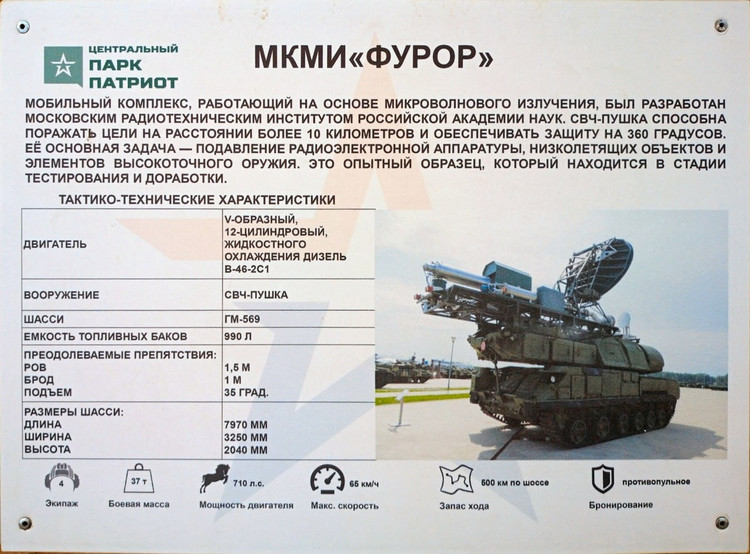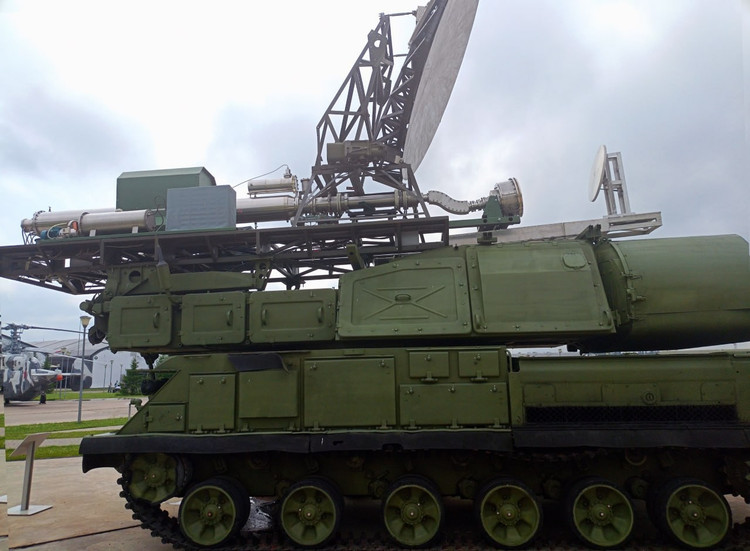Known for many years only as Furor, the Russian-designed mobile directional microwave radiation system has made its first public appearance at the famous armored vehicle museum in the city of Kubinka.
Photos of the directed energy weapon from the event, shared by Btvt.info, show a prototype that is still undergoing testing and awaiting completion, according to a Russian promotional material. That is, not much has been done in the past decade, considering the system was first introduced at the restricted area of the Army-2015 military exhibition in Russia.

The anti-UAV microwave system was introduced under the name Furor in 2015. Photo: Army 2015
Furor is designed to neutralize drones and precision-guided munitions. It is said to have an all-directional defense capability at a range of more than 10 kilometers (a little over 6 miles).
By comparison, a similar US-based system, the Epirus Leonidas, can only engage threats within 2 kilometers of its location. While the company has sought to increase this range, such a limited range actually reflects the capabilities of the technology at this stage of development.
Meanwhile, Russia’s claims are far from reality—an ambitious goal that was never intended to be achieved, only pursued while funding was still available. No tests have been reported to confirm the system’s operational capabilities, let alone its target performance characteristics.
Above all, this situation is not new: the S-70 Okhotnik UAV, the BMP-3 unmanned combat vehicle, and the Peresvet laser are all long-term projects with more promise than substance, constantly shifting deadlines, and no evidence of feasibility in practice.
In terms of design, the Furor consists of "a high-power generator combined with a reflector antenna, a management and control system, and a transmission system", as revealed to Russian media in 2015. All are mounted on the tracked chassis of the Buk air defense system.

Furor mobile combat microwave radiation system / Photo: Btvt.info
Some Russian media have mentioned the possibility of integrating microwave weapons into a broader air defense network—but that was not part of the original project. In practice, however, this could make sense as a point defense solution to protect other air defenses from drones.
The Moscow Radio Engineering Institute, a division of Vega, is responsible for developing the Furor system. Vega is best known for its radar reconnaissance equipment, including the A-50, A-50U and A-100 airborne early warning and control systems, which are no longer in production.

A-100 Premier during a test flight in February 2022 / Open source photo
In other words, a specialized Russian organization has been creating a complex niche technology for years, and its parent company is known for its questionable performance. The result is another wonder product that, instead of being used in real life, has appeared in an exhibition and reappeared in a museum.
In short, it is difficult to say whether the Russians will actually continue developing Furor. On the one hand, presenting it as an exhibition may indicate a loss of confidence in the project, on the other hand, they still write that this prototype is being tested and refined.
However, while the technology has potential, the chances of Russia successfully deploying it into an operational weapon are slim. Sure, they could continue to pour money into the program, but that is not feasible given the system specifications they are trying to achieve.
Source: https://khoahocdoisong.vn/loai-vu-khi-nga-mat-10-nam-phat-trien-roi-dua-vaobao-tang-post1556777.html































![[Photo] National Assembly Chairman attends the seminar "Building and operating an international financial center and recommendations for Vietnam"](https://vphoto.vietnam.vn/thumb/1200x675/vietnam/resource/IMAGE/2025/7/28/76393436936e457db31ec84433289f72)





































































Comment (0)